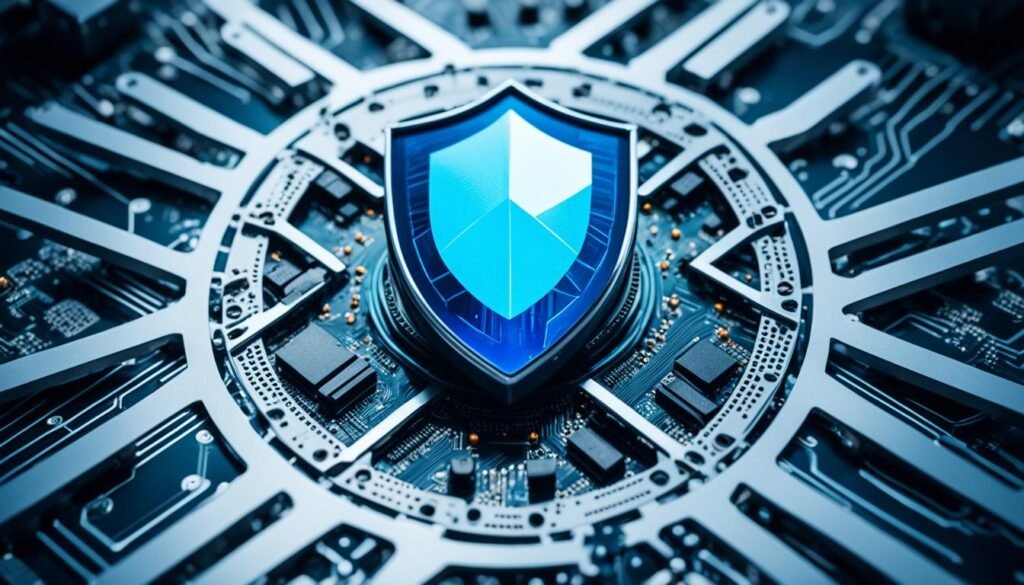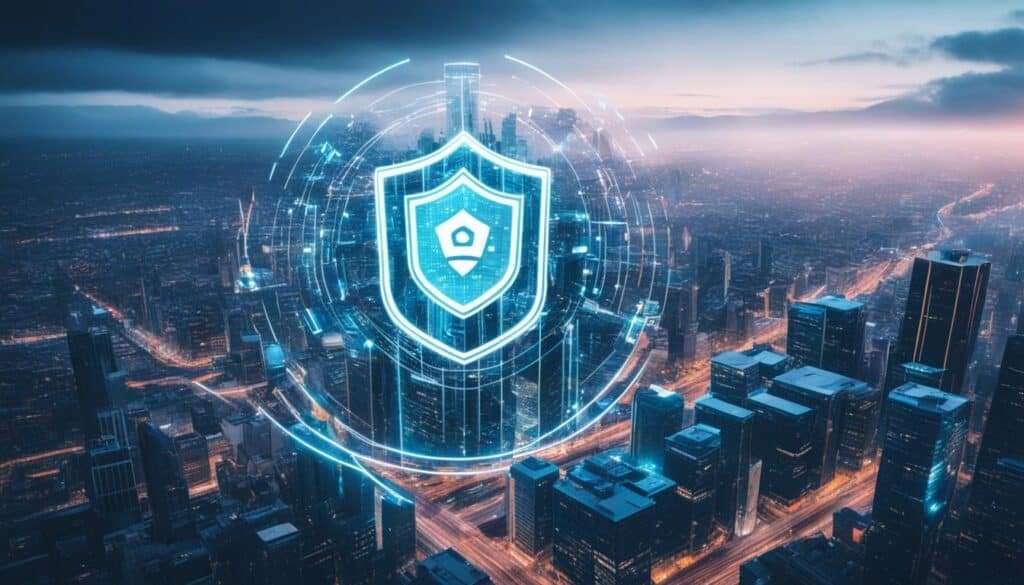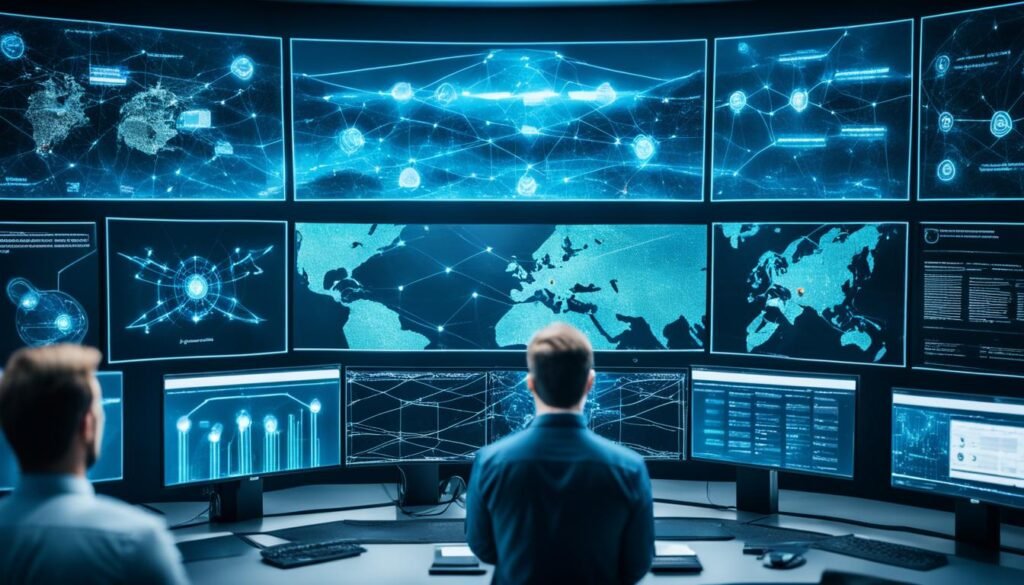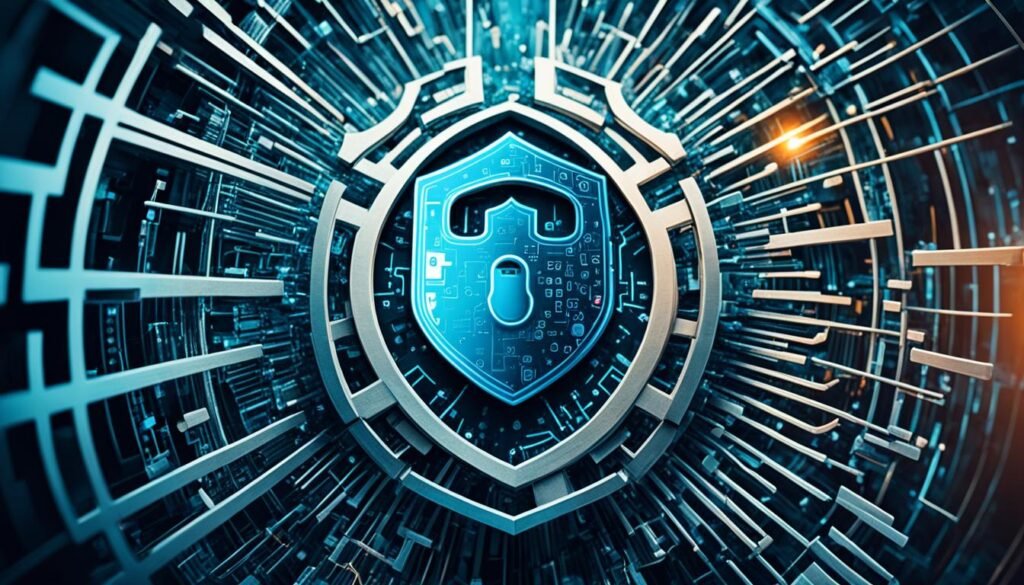In today’s world, staying safe online is more complex than ever. With new cyber threats always appearing, companies are looking for new ways to protect their information. They are using artificial intelligence (AI) to improve their cybersecurity. AI is a big help, giving companies tools to quickly spot and stop online dangers.
AI can sort through big amounts of data, looking for anything that seems off. It can catch threats that other security methods might overlook. These smart AI agents can watch, learn, and act when they see a risk. This includes finding weak spots in programs, spotting odd user actions, and discovering new computer viruses. More and more, companies are making AI a main part of their protection plans.
Key Takeaways
- Artificial intelligence is transforming the cybersecurity landscape, providing organizations with advanced tools to detect, prevent, and respond to cyber threats.
- AI-powered cybersecurity solutions can analyze large volumes of data, identify anomalies, and detect potential threats that traditional security measures might miss.
- AI-based intelligent agents can observe, learn, and make decisions to address specific security challenges, such as finding vulnerabilities, recognizing unusual user behavior, and identifying new types of malware.
- The integration of AI in cybersecurity is steadily increasing as organizations recognize its value in enhancing their overall security strategy.
- AI-driven cybersecurity measures are crucial in addressing the evolving and complex threat landscape faced by organizations in the digital age.
The Evolving Threat Landscape
Our world is getting more digital every day. Because of this, the danger from cyber threats is growing fast. Threats like malware, phishing, denial-of-service attacks, insider threats, and advanced persistent threats are becoming more complex. They’re hard to fight against too. These threats are serious for people, groups, and even whole countries.
Types of Cyber Threats
The internet is full of different cyber threats, each with their ways to cause problems. Common threats include:
- Malware: Gets into computer systems and networks to cause harm or steal info.
- Phishing: Tries to trick you into sharing personal information or financial details.
- Denial-of-Service (DoS) Attacks: Floods a website or network with traffic to make it stop working.
- Insider Threats: Harm that comes from within an organization, like from unhappy employees with access to secrets.
- Advanced Persistent Threats (APTs): Slick, longtime attacks targeting specific organizations to steal important data or cause chaos.
The Changing Nature of Cyber Attacks
Cyber threats keep changing because technology evolves so quickly. Attackers are always coming up with new ways to break through security. They’re making their attacks more targeted and hard to spot. To keep safe, groups must update their security often and check for new kinds of threats.
“The cyber threat landscape is constantly evolving, driven by the rapid advancement of technology and the ingenuity of malicious actors.”
The Rise of Artificial Intelligence in Cybersecurity

In today’s digital world, artificial intelligence (AI) is changing how we handle threats. AI technologies help organizations protect their systems. They can spot and handle cyber threats faster than before.
AI’s main tools, like machine learning algorithms, natural language processing, and predictive analytics, are key. They make our systems smarter. This means they can see risks coming before they actually hit.
For example, machine learning lets systems learn from past threats. They get better at spotting new threats over time. This helps security teams react quickly and effectively.
Natural language processing helps systems understand messy, hard-to-read data. This kind of data often holds clues about upcoming cyber attacks. By understanding this type of data, AI can catch threats that might slip past traditional defenses.
Predictive analytics is also vital. It uses past data to predict future threats. By preparing for these threats, companies can protect themselves better. They can strengthen their defenses before an attack occurs.
“Artificial intelligence is not just a game-changer in cybersecurity, it’s a fundamental shift in how we approach the ever-evolving threat landscape. By harnessing the power of AI, we can stay ahead of the curve and ensure the security and resilience of our digital systems.”
As cyber threats become more complex, AI’s role in security is crucial. It uses machine learning, natural language processing, and predictive analytics to make our defenses stronger. This means we can react to threats quickly and accurately.
Key AI Technologies in Cybersecurity

Artificial Intelligence (AI) changes the game in cybersecurity, enhancing defenses against cyber threats. At its heart, AI uses machine learning algorithms, natural language processing (NLP), and predictive analytics to stay sharp.
Machine Learning Algorithms
Machine learning lets systems get better at spotting threats without being told how. It’s great at finding patterns, oddities, and possible dangers in big amounts of data. This helps AI systems detect new threats faster than ever.
Natural Language Processing
This tech lets machines understand, interpret, and use language like we do. In cybersecurity, that means quickly going through texts to find security risks. It can look at tons of data to pick out hidden problems.
Predictive Analytics
Predictive analytics looks at the past to guess future cyber threats. By knowing what might come, organizations can make their defenses stronger. This makes them better at preventing attacks and handling any that do happen.
| AI Technology | Application in Cybersecurity |
|---|---|
| Machine Learning Algorithms | Detecting patterns, anomalies, and potential threats in vast datasets |
| Natural Language Processing (NLP) | Analyzing textual data, such as logs and threat intelligence reports, to extract meaningful insights and identify potential security issues |
| Predictive Analytics | Forecasting future cyber threats based on historical data and ongoing trends, enabling proactive security strategies |
Using machine learning, natural language processing, and predictive analytics helps make cyber defenses stronger. This puts organizations in a better place to handle new cyber threats and avoid attacks.
AI-Powered Threat Detection

In today’s changing world of cybersecurity, artificial intelligence (AI) shines as a top ally. It helps boost our ability to spot threats. With AI, systems can quickly find patterns, oddities, and potential dangers. This gives companies a stronger shield against a variety of cyber risks.
Anomaly Detection
AI plays a crucial role in spotting abnormal activities – a big job in security. It starts by learning what’s normal for a system or network. Then, it watches for anything out of the ordinary. This could be user actions, device connections, or the flow of data. Thanks to AI, these oddities get flagged fast. This means security teams can act quickly to prevent harm.
Behavioral Analysis
Building on spotting anomalies, AI also dives into understanding and foreseeing user, device, and app actions. By sifting through huge data sets, it spots unusual patterns in how people or technology act. This helps uncover inside jobs or advanced attacks that old detection methods could miss. Knowing how users normally behave helps teams stay on top of possible risks.
So, bringing AI into the mix has really amped up organizations’ cyber defense. It lets them react faster to new threats and defend their vital digital grounds more effectively.
| AI-Powered Threat Detection Capabilities | Benefits |
|---|---|
| Anomaly Detection | Rapidly identifies deviations from normal behavior, signaling potential security threats |
| Behavioral Analysis | Understands and predicts user, device, and application behavior to detect sophisticated attacks |
| Real-time Monitoring and Alerting | Enables swift response and mitigation of security incidents |
Cybersecurity

Cybersecurity is a big deal in today’s world. It covers all the ways we protect digital stuff from bad guys. There are a lot of cyber threats out there, and they keep getting more complex. Because of this, we need new cybersecurity methods to keep up.
There are serious cyber threats like APTs, ransomware, and data breaches. They’ve shown us how important it is to keep our networks and data safe. Bad actors are always looking for ways to get in and cause trouble. Using old-fashioned security just isn’t enough anymore.
To fight these new threats, many groups are using artificial intelligence (AI) and machine learning (ML). These tools learn from past attacks and can spot new ones quickly. They help catch bad actions before they do a lot of harm.
AI doesn’t just help find threats; it can also make responding to attacks faster. It can help contain and fix problems without as much human effort. This makes everything run smoother after an attack.
The world of cybersecurity is always changing. More AI and new tech will be key in keeping our digital things safe. Using these tools, we can protect our important data and keep our systems strong against cyber threats.
AI-Driven Incident Response

The cybersecurity world keeps changing. Now, artificial intelligence (AI) is set to completely change how we handle security incidents. With AI, our security teams can quickly find, stop, and fix security problems. This makes them work better and faster.
Automated Playbooks
AI-powered playbooks help security teams. They follow a set of rules and do what’s needed when a problem comes up. These playbooks use smart programs to look at the data, find what’s wrong, and fix it. So, security teams can handle more incidents and do it faster.
Orchestration and Automation
AI makes the teamwork of security much smoother. It brings together different security tools and makes them work as one. This means when a threat shows up, security teams can act together and quickly. It makes the security process run better and helps them protect us more.
| Benefits of AI-Driven Incident Response | Key Capabilities |
|---|---|
|
|
By making use of AI in security, organizations can make their cyber defenses stronger. They can handle security incidents better in a more complicated threat world. This helps them keep their digital world safe and secure.
“AI-driven automation in incident response is a game-changer, allowing security teams to respond to threats more quickly and efficiently than ever before.”
Enhancing Security Analytics with AI

AI-powered security analytics are changing the game in cybersecurity. They use artificial intelligence to improve how quickly and accurately we find, check, and deal with security problems.
AI is great at advanced data analysis. It looks at lots of security data to find patterns and strange things people might miss. This helps find threats and problems faster, leading to quicker reactions to keep things safe.
AI-driven threat detection is a big step forward in staying safe from cyber dangers. These systems learn from past issues, spot new trends, and predict attacks. This knowledge makes it easier to beef up security and react to problems effectively.
AI is a big help in dealing with problems when they happen, too. It looks at what went wrong, how big the issue is, and the best ways to fix it. Automating this analysis helps respond to incidents faster and smarter, improving security strategies.
Using AI-powered security analytics makes organizations more secure and ready for changing threats. AI is crucial in today’s digital world for better security and smart decisions to safeguard important data.
“Artificial intelligence has the potential to revolutionize the way we approach cybersecurity, empowering organizations to make more informed, data-driven decisions in the face of ever-evolving threats.”
Addressing the AI Cybersecurity Skills Gap

Many organizations are adding AI to their cybersecurity efforts. But they’re running into trouble finding enough skilled people in AI cybersecurity. These experts are really wanted but there are not many.
To deal with this, companies should focus on training and education. They should help their current teams learn how to use AI for security better. And companies should also look for new talent with these skills.
Training their teams will get them up to speed on AI. They can do this through special classes and workshops. These will focus on using AI for spotting threats, dealing with problems, and analyzing security issues.
At the same time, companies need to find and hire people who are knowledgeable in AI and cybersecurity. They should work with schools and think of new ways to pick the best talent. Offering good pay and chances for career growth can help.
It’s important for these security experts to keep learning about AI. The AI field is always changing. So, to keep up, security teams must keep learning too. Having a culture of ongoing education and offering training opportunities can make a big difference.
By working on both training and hiring, companies can use AI to make their security better. They should make sure their teams have the right skills to face cyber threats.
“The future of cybersecurity lies in the seamless integration of AI and human expertise. By bridging the skills gap, organizations can elevate their security capabilities and stay one step ahead of the evolving threat landscape.”
Ethical Considerations and Risks

Artificial intelligence (AI) is making its way into cybersecurity. It’s vital to look at the ethical issues and possible dangers tied to these advances. Concerns like data privacy, algorithm bias, and how decision-making systems work need a close look. This ensures AI is used responsibly and ethically.
The safeguarding of private information and preventing data misuse is a big issue. AI in cybersecurity needs to analyze lots of personal data to fight threats. Organizations need to create strong rules and clear ways to make sure they use data safely and follow laws, like the GDPR.
Algorithm bias sneaking into AI security systems is another problem. If the data these algorithms learn from is one-sided or not enough, their choices might not be fair. Solving this needs a deep look into how these systems make decisions, plus strict tests to check if they’re fair.
The more that AI systems in cybersecurity can act on their own, the more ethical questions there are. How do we make sure they don’t hurt people or cause problems without anyone checking? Groups must set up clear rules and choose ways to guarantee these autopilot systems work in ways that are right and safe for everyone.
To deal with the ethical challenges brought by AI in security, teamwork and open talks are crucial. Pulling together hard talks with everyone invested, like cybersecurity pros, policymakers, and civil groups, helps a lot. This way, they can come up with ethical AI strategies that put people first, are open, and cut down the risks of using these techs.
“The responsible development and deployment of AI in cybersecurity is not only a technical challenge but also an ethical imperative that requires careful consideration and collaboration among all stakeholders.”
Also Read: How Do Technology Applications Improve Business Efficiency?
Conclusion
Artificial Intelligence is changing cybersecurity. It makes finding and stopping cyber threats better. Thanks to machine learning and natural language processing, AI now spots dangers early. That means it helps stop bad activities before they cause real harm.
AI is also aiding in how we respond to cyber attacks. It automates some security tasks, making teams faster and more efficient. This way, experts can handle dangers with better speed and skill. Plus, AI gives them more insights. This helps them make smarter safety choices, which boosts their defenses.
But there are challenges as AI grows in cybersecurity. One big issue is a lack of enough skilled workers. Also, we need to deal well with the ethical sides of AI in this arena. The future success of keeping cyber threats at bay will depend on AI teams working with human experts. They will need to come together to fight off the many digital dangers.
FAQs
What is the role of Artificial Intelligence in enhancing cybersecurity measures?
Artificial Intelligence (AI) boosts security by using new tech to handle old problems. It checks lots of data quickly and looks out for new threats. With AI, systems get better at fighting off bad actions.
What are the different types of cyber threats organizations face today?
Cyber threats, like malware and phishing, are many. They also include attacks from within and by sneaky sources. Dealing with these is always getting harder as attacks change and get smarter.
How is Artificial Intelligence transforming the field of cybersecurity?
AI is changing the way we look at cyber danger in big ways. It uses smart algorithms and data language to make security sharper. This helps find threats faster and keep systems safer.
What are the key AI technologies used in cybersecurity?
AI in cybersecurity uses smart algorithms, data language, and predictions. These tools team up to make sure digital safety is strong against attacks.
How does AI-powered threat detection work?
AI threat detection uses learning systems to spot dangers by watching user behavior and system patterns. It finds unusual actions to catch early warning signs of new threats. This helps stop attacks before they do harm.
What is the role of AI in incident response and security analytics?
AI helps quickly respond to and fix security issues by spotting them early. It also organizes security jobs to work together better. AI makes it easier to figure out what went wrong and how to fix it fast.
What are the challenges in addressing the AI cybersecurity skills gap?
Getting the right AI skills in cybersecurity is hard for many groups. They need more experts who know both AI and security well. This means offering more training and finding new people with the right skills.
What are the ethical considerations and potential risks associated with the use of AI in cybersecurity?
Using AI in security comes with big ethics and risk questions. Things like keeping data safe and making fair choices matter a lot. To solve these, we need strong rules, clear actions, and to stay talking with everyone involved.
Source Links
- https://medium.com/@analyticsemergingindia/the-role-of-artificial-intelligence-in-cybersecurity-enhancing-threat-detection-and-response-6ca0b202be72
- https://www.encryptionconsulting.com/the-role-of-artificial-intelligence-ai-in-modern-cybersecurity/
- https://www.ccslearningacademy.com/role-of-ai-in-cyber-security/




